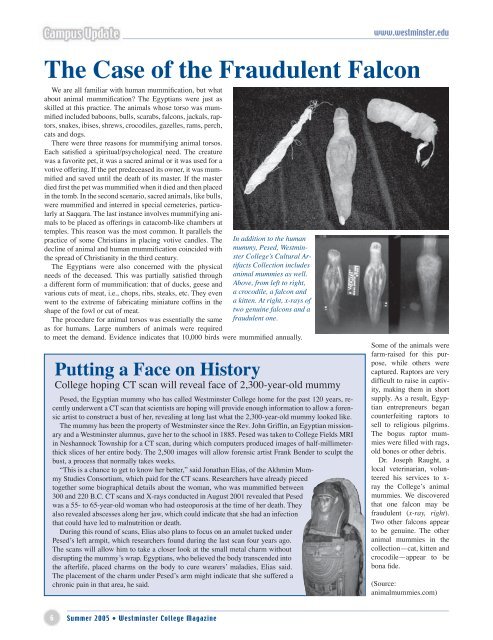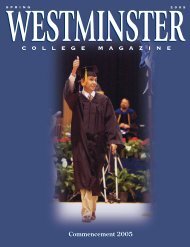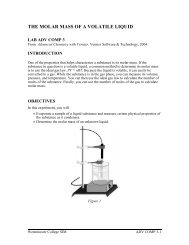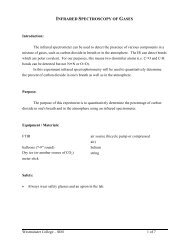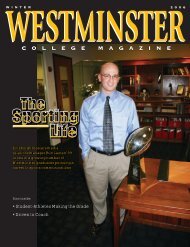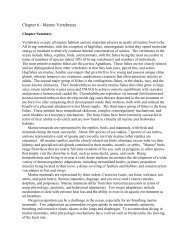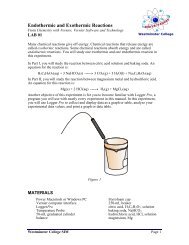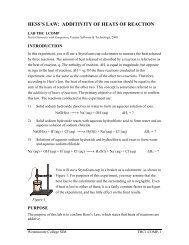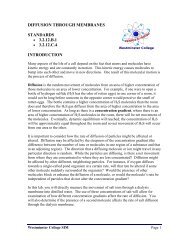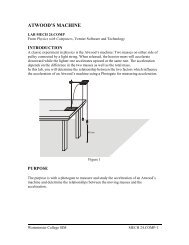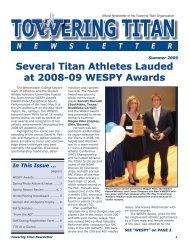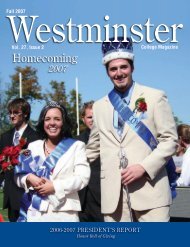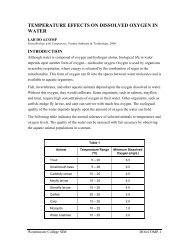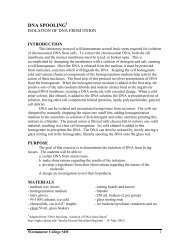download pdf (2.56 MB) - Westminster College
download pdf (2.56 MB) - Westminster College
download pdf (2.56 MB) - Westminster College
Create successful ePaper yourself
Turn your PDF publications into a flip-book with our unique Google optimized e-Paper software.
www.westminster.edu<br />
The Case of the Fraudulent Falcon<br />
We are all familiar with human mummification, but what<br />
about animal mummification The Egyptians were just as<br />
skilled at this practice. The animals whose torso was mummified<br />
included baboons, bulls, scarabs, falcons, jackals, raptors,<br />
snakes, ibises, shrews, crocodiles, gazelles, rams, perch,<br />
cats and dogs.<br />
There were three reasons for mummifying animal torsos.<br />
Each satisfied a spiritual/psychological need. The creature<br />
was a favorite pet, it was a sacred animal or it was used for a<br />
votive offering. If the pet predeceased its owner, it was mummified<br />
and saved until the death of its master. If the master<br />
died first the pet was mummified when it died and then placed<br />
in the tomb. In the second scenario, sacred animals, like bulls,<br />
were mummified and interred in special cemeteries, particularly<br />
at Saqqara. The last instance involves mummifying animals<br />
to be placed as offerings in catacomb-like chambers at<br />
temples. This reason was the most common. It parallels the<br />
practice of some Christians in placing votive candles. The In addition to the human<br />
decline of animal and human mummification coincided with mummy, Pesed, <strong>Westminster</strong><br />
<strong>College</strong>ʼs Cultural Ar-<br />
the spread of Christianity in the third century.<br />
The Egyptians were also concerned with the physical tifacts Collection includes<br />
needs of the deceased. This was partially satisfied through animal mummies as well.<br />
a different form of mummification: that of ducks, geese and Above, from left to right,<br />
various cuts of meat, i.e., chops, ribs, steaks, etc. They even a crocodile, a falcon and<br />
went to the extreme of fabricating miniature coffins in the a kitten. At right, x-rays of<br />
shape of the fowl or cut of meat.<br />
two genuine falcons and a<br />
The procedure for animal torsos was essentially the same fraudulent one.<br />
as for humans. Large numbers of animals were required<br />
to meet the demand. Evidence indicates that 10,000 birds were mummified annually.<br />
Putting a Face on History<br />
<strong>College</strong> hoping CT scan will reveal face of 2,300-year-old mummy<br />
Pesed, the Egyptian mummy who has called <strong>Westminster</strong> <strong>College</strong> home for the past 120 years, recently<br />
underwent a CT scan that scientists are hoping will provide enough information to allow a forensic<br />
artist to construct a bust of her, revealing at long last what the 2,300-year-old mummy looked like.<br />
The mummy has been the property of <strong>Westminster</strong> since the Rev. John Griffin, an Egyptian missionary<br />
and a <strong>Westminster</strong> alumnus, gave her to the school in 1885. Pesed was taken to <strong>College</strong> Fields MRI<br />
in Neshannock Township for a CT scan, during which computers produced images of half-millimeterthick<br />
slices of her entire body. The 2,500 images will allow forensic artist Frank Bender to sculpt the<br />
bust, a process that normally takes weeks.<br />
“This is a chance to get to know her better,” said Jonathan Elias, of the Akhmim Mummy<br />
Studies Consortium, which paid for the CT scans. Researchers have already pieced<br />
together some biographical details about the woman, who was mummified between<br />
300 and 220 B.C. CT scans and X-rays conducted in August 2001 revealed that Pesed<br />
was a 55- to 65-year-old woman who had osteoporosis at the time of her death. They<br />
also revealed abscesses along her jaw, which could indicate that she had an infection<br />
that could have led to malnutrition or death.<br />
During this round of scans, Elias also plans to focus on an amulet tucked under<br />
Pesedʼs left armpit, which researchers found during the last scan four years ago.<br />
The scans will allow him to take a closer look at the small metal charm without<br />
disrupting the mummyʼs wrap. Egyptians, who believed the body transcended into<br />
the afterlife, placed charms on the body to cure wearersʼ maladies, Elias said.<br />
The placement of the charm under Pesedʼs arm might indicate that she suffered a<br />
chronic pain in that area, he said.<br />
Some of the animals were<br />
farm-raised for this purpose,<br />
while others were<br />
captured. Raptors are very<br />
difficult to raise in captivity,<br />
making them in short<br />
supply. As a result, Egyptian<br />
entrepreneurs began<br />
counterfeiting raptors to<br />
sell to religious pilgrims.<br />
The bogus raptor mummies<br />
were filled with rags,<br />
old bones or other debris.<br />
Dr. Joseph Raught, a<br />
local veterinarian, volunteered<br />
his services to x-<br />
ray the <strong>College</strong>ʼs animal<br />
mummies. We discovered<br />
that one falcon may be<br />
fraudulent (x-ray, right).<br />
Two other falcons appear<br />
to be genuine. The other<br />
animal mummies in the<br />
collection—cat, kitten and<br />
crocodile—appear to be<br />
bona fide.<br />
(Source:<br />
animalmummies.com)<br />
6 Summer 2005 • <strong>Westminster</strong> <strong>College</strong> Magazine


